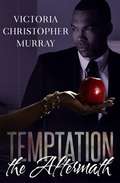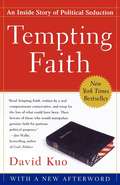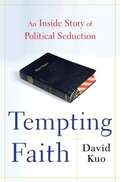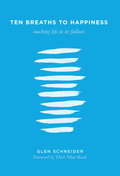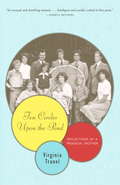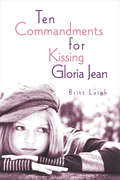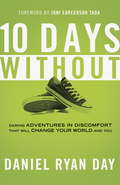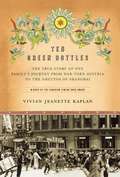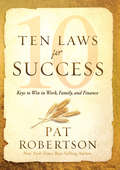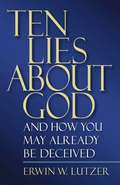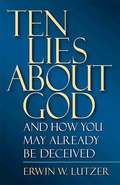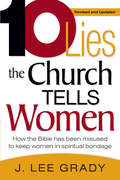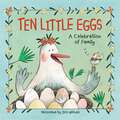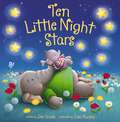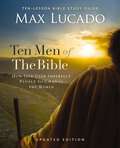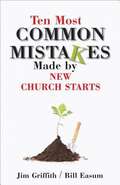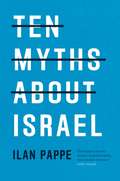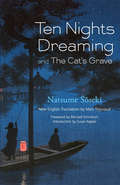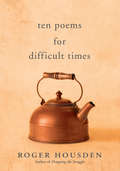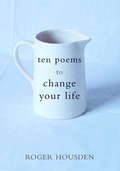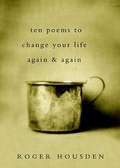- Table View
- List View
Temptation: The Aftermath
by Victoria Christopher MurrayThe best of friends…. Since they were five years old, Jasmine Cox Larson Bush and Kyla Blake had a bond that could not be broken. They shared secrets, marked milestones, and held each other up through life’s adversities. It was a friendship that they both thought would last forever. But when Jasmine’s jealousy led her to seduce Kyla’s husband, Dr. Jefferson Blake, that bond was severed and their friendship was damaged forever…. The worst of times…. Now, twenty years later, a major tragedy brings the two together when Jefferson, in New York for a medical convention, is shot in an attempted robbery. It’s the love that Jasmine once had for Kyla that sends her rushing to the hospital to be by her friend’s side. Kyla, despondent and distraught, just wants answers….and when a mysterious woman appears, it’s Jasmine who believes that woman may hold the key to what happened to Jefferson. While Kyla doesn’t believe that this woman has any meaning, Jasmine is not so sure. Will Jasmine uncover a secret that Jefferson is hiding? And when she does find out the truth, what will she do with it? Will she destroy Kyla’s life or will she do anything to protect her friend from the same devastation that she caused her twenty years before? In a riveting twenty-year anniversary sequel to the bestselling Temptation, Victoria Christopher Murray weaves a tale of what happens once friendships are bonded, then broken and all the consequences of the aftermath.
Temptation: The Aftermath
by Victoria Christopher MurrayKyla and Jefferson Blake count their 16 years together as a wonderful blessing from God. Their marriage is passionate, their daughter is a joy, Jefferson's medial career is prospering and they have loyal friends. Kyla knows her newly divorced and lifelong friend, Jasmine, is desperately unhappy and no amount of prayer or encouragement seems to help. But what Kyla doesn't know is that Jasmine has a plan to move her life forward with the type of man she feels she should have married in the first place. A man like Jefferson. Alexis Ward, Kyla's, best friend, is single and successful and willing to wait for the right man for all the right reasons. But, when "Mr. Right," Dr. Brian Lewis, finally appears she finds herself facing a new challenge. Does she really have to walk away from what she believes in order to have a man in her life? As people who love God, Kyla, Jefferson and Alexis discover, each in their own way, what happens when they truly allow God to be first in their relationships. Full of contemporary characters who struggle to keep their strength, friendships and daily lives framed by the Word of God, Temptation is a novel no reader will soon forget.
Tempting Faith
by David KuoDavid Kuo came to Washington wanting to use his Christian faith to end abortion, strengthen marriage, and help the poor. He reached the heights of political power, ultimately serving in the White House under George W. Bush, after being policy adviser to John Ashcroft and speechwriter for Ralph Reed, Pat Robertson, and Bob Dole. It was a dream come true: the chance to fuse his politics and his faith, and an opportunity for Christians not just to gain a seat at the proverbial table but to plan the entire meal. Kuo spent nearly three years as second in command at the president's Office of Faith-Based and Community Initiatives. Yet his experience was deeply troubling. It took both the Bush White House and a severe health crisis to show him how his Christian values, and those of millions of Americans, were being corrupted by politics. Instead of following the teachings of Jesus to serve the needy, Kuo found himself helping to manipulate religious faith for political gain. Public funds were used in battleground states, for Republican campaign events. The legislative process was used as a football, not to pass laws but to deepen purely symbolic fault lines. Grants were incestuously recycled to political cronies. Both before and after 9/11, despite lofty rhetoric from the president claiming that his faith-based program was one of his most important initiatives, there was no serious attempt to fund valuable charities. Worst of all was the prevailing attitude in the White House and throughout Washington toward Christian leaders. Key Bush aides and Republican operatives spoke of them with contempt and treated them as useful idiots. It became clear, during regular conference calls arranged from the White House with a key group of Christian leaders, that many of these religious leaders had themselves been utterly seduced by politics. It is time, Kuo argues, for Christians to take a temporary step back from politics, to turn away from its seductions. Tempting Faith is equal parts headline-making exposé, political and spiritual memoir, and heartfelt plea for a Christian reexamination of political involvement.
Tempting Faith: An Inside Story of Political Seduction
by David KuoFrom the Book Jacket: Kuo spent nearly three years as second in command at the president's Office of Faith-Based and Community Initiatives. Yet his experience was deeply troubling. It took both the Bush White House and a severe health crisis to show him how his Christian values, and those of millions of Americans, were being corrupted by politics. Instead of following the teachings of Jesus to serve the needy, Kuo found himself helping to manipulate religious faith for political gain. Public funds were used in battleground states, for Republican campaign events. The legislative process was used as a football, not to pass laws but to deepen purely symbolic fault lines. Grants were incestuously recycled to political cronies. Both before and after 9/11, despite lofty rhetoric from the president claiming that his faith-based program was one of his most important initiatives, there was no serious attempt to fund valuable charities. Worst of all was the prevailing attitude in the White House and throughout Washington toward Christian leaders. Key Bush aides and Republican operatives spoke of them with contempt and treated them as useful idiots. It became clear, during regular conference calls arranged from the White House with a key group of Christian leaders, that many of these religious leaders had themselves been utterly seduced by politics. It is time, Kuo argues, for Christians to take a temporary step back from politics, to turn away from its seductions. Tempting Faith is equal parts headline-making exposé, political and spiritual memoir, and heartfelt plea for a Christian reexamination of political involvement. David Kuo served as Special Assistant to the President under George W. Bush from 2001 to 2003. He has worked for numerous conservative leaders, including John Ashcroft, William Bennett, Jack Kemp, Bob Dole, and Ralph Reed. He is the author of the Good Morning America Book Club selection Dot.Coming: My Days and Nights at an Internet Goliath. He currently serves as the Washington editor of the Beliefnet Web site.
Ten Breaths to Happiness
by Thich Nhat Hanh Jason Deantonis Glen SchneiderSimple practices to help us cultivate happiness and fulfillment in the course of our daily lives.Happiness is far more than a positive feeling that comes and goes, happiness is wired into the physiology of our brains. It is a skill we can all develop through cultivating mindfulness and concentration. In Ten Breaths to Happiness Schneider presents a series of simple practices and guided meditations that allow you to literally rewire your neural pathways to experience deeper and more lasting fulfillment and peace.Studies in neuroscience show that it takes about thirty seconds to build a new neural-pathway. Schneider takes these findings and combines them with mindfulness practices based on the teachings of Zen teacher Thich Nhat Hanh. For example, he encourages us to take ten conscious breaths whenever we encounter something beautiful or have a meaningful experience. Consistently exercising this simple practice creates an opportunity for the brain to move from its default reaction of protection to one of appreciation and spaciousness.In ten short chapters, Schneider discusses the nature of happiness and its role in our evolution. He shows how our brains can make us happy or create suffering, and he introduces simple, proven techniques that will shape our brains over
Ten Breaths to Happiness: Touching Life in its Fullness
by Glen SchneiderZen teacher Glen Schneider has developed a series of simple practices to help us cultivate happiness and fulfillment in the course of our daily lives. Happiness is far more than a positive feeling that comes and goes, happiness is wired into the physiology of our brains. It is a skill we can all develop through cultivating mindfulness and concentration. In Ten Breaths to Happiness Schneider presents a series of simple practices and guided meditations that allow you to literally rewire your neural pathways to experience deeper and more lasting fulfillment and peace.Studies in neuroscience show that it takes about thirty seconds to build a new neural-pathway. Schneider takes these findings and combines them with mindfulness practices based on the teachings of Zen teacher Thich Nhat Hanh. For example, he encourages us to take ten conscious breaths whenever we encounter something beautiful or have a meaningful experience. Consistently exercising this simple practice creates an opportunity for the brain to move from its default reaction of protection to one of appreciation and spaciousness.In ten short chapters, Schneider discusses the nature of happiness and its role in our evolution. He shows how our brains can make us happy or create suffering, and he introduces simple, proven techniques that will shape our brains over time to experience more joy and be more fulfilled in everyday life.Written for adults new to meditation as well as those with previous meditation experience, Ten Breaths to Happiness is a practical, highly accessible book that not only brings us up-to-date with the latest developments in neuroscience but offers simple exercises that can be done anywhere, any time, to help 'rewire our brains' and maximize our potential.
Ten Circles Upon the Pond
by Virginia TranelTen Circles Upon the Pond is a book for anyone who's ever lived in that unwieldy group called family--a story of passion, intimacy, work, religion, puberty, love and loss, and the struggle to be steadfast in times of enormous social change. Rooted in real-life experience, this unique, beautifully written collection of essays reads like a novel--full of lively characters, spirited dialogue, and a landscape that takes you from Iowa to the high country of Wyoming and Montana. As the chapters unfold, one focused on each child, Virginia Tranel and her husband search for the ideal place to raise the five daughters and five sons born to them between 1957 and 1978. Tranel artfully weaves daily moments with world events as she reflects on how our culture affects our decisions. She offers candid observations on everything from her reproductive choices and feminism's influence on her thinking to sibling rivalries and her family's emotional response when an architect son emails firsthand reports of the horrors of September 11. Whether considering the issues intrinsic to marriage and child-raising, or questioning her own common sense, her insights are always provocative and deeply moving.
Ten Commandments for Kissing Gloria Jean
by Britt LeighA 14-year-old girl who wants her first kiss more than anything gets diagnosed with Celiac disease, prompting important considerations about her body and her Catholic faith. Themes include: faith, choices, and sex & relationships.
Ten Days Without
by Joni Eareckson Tada Daniel Ryan DayA Rebellion against Apathy. A Strategy for Action. "Life is full of good intentions, but for too many, our good intentions never become good actions--they don't move us forward, draw us closer to God, or make a difference in the world. Good intentions are cans of paint that could have become amazing works of art...but never did." --Daniel Day, in Ten Days Without Daniel Day could tell you all about his love for God and his desire to live as a follower of Jesus. But it took a simple but radical experiment to move from simply talking about it to actually living like it. For ten days at a time, Daniel chose to abandon a certain "necessity"--a coat, a voice, shoes, media, furniture, legs, touch--and to blog about it to raise funds and awareness for organizations that are doing amazing things to make a difference in the world. And then he invited others to join him in the experiments and spread the vision. Together they served God and others--and experienced significant personal change in the process. Ten Days Without is the story of their life-altering adventure. Ten Days Without is a compelling story and practical guide that will equip you and your friends to break through walls of convenience and indifference, and join a movement that is confronting apathy and ignorance around the world to make an impact on people's lives in a God-honoring way. Ten Days Without is where our good intentions end and making a difference in the world begins.
Ten Gates: The Kong-an Teaching of Zen Master Seung Sahn
by Seung SahnZen is famous for koans (called kong-ans in Korean, and in this book), those bizarre and seemingly unanswerable questions Zen masters pose to their students to check their realization (such as "What is the sound of one hand clapping?"). Fear of koans keeps some people from ever giving Zen practice a try. But here, through the experience of seeing a modern Zen master work with his students, you can see what koan training is really like: It's a skillful, lively practice for attaining wisdom.This book presents the system of ten koans that Zen Master Seung Sahn came to call the "Ten Gates." These koans represent the basic types one will encounter in any course of study. Each of the ten gates, or koans, is illuminated by actual interchanges between Zen Master Seung Sahn and his students that show what the practice is all about: it is above all a process of coming to trust one's own wisdom, and of manifesting that wisdom in every koan-like situation life presents us with.For more information on the author, Zen Master Seung Sahn, visit his website at www.kwanumzen.com.
Ten Green Bottles: The True Story of One Family's Journey From War-Torn Austria to the Ghettos of Shanghai
by Vivian Jeanette KaplanTo Nini Karpel, growing up in Vienna during the 1920s was a romantic confection. Whether schussing down ski slopes or speaking of politics in coffee houses, she cherished the city of her birth. But in the 1930s an undercurrent of conflict and hate began to seize the former imperial capital. This struggle came to a head when Hitler took possession of neighboring Germany. Anti-Semitism, which Nini and her idealistic friends believed was impossible in the socially advanced world of Vienna, became widespread and virulent. The Karpel's Jewish identity suddenly made them foreigners in their own homeland. Tormented, disenfranchised, and with a broken heart, Nini and her family sought refuge in a land seven thousand miles across the world. Shanghai, China, one of the few countries accepting Jewish immigrants, became their new home and refuge. Stepping off the boat, the Karpel family found themselves in a land they could never have imagined. Shanghai presented an incongruent world of immense wealth and privilege for some and poverty for the masses, with opium dens and decadent clubs as well as rampant disease and a raging war between nations. Ten Green Bottles is the story of Nini Karpel's struggles as she told it to her daughter Vivian so many years ago. This true story depicts the fierce perseverance of one family, victims of the forces of evil, who overcame suffering of biblical proportion to survive. It was a time when ordinary people became heroes.
Ten Laws for Success: Keys to Win in Work, Family, and Finance
by Pat RobertsonFrom Renowned Religious Leader and Host of The 700 Club, Pat Robertson. Know not just how the world works, but how it&’s supposed to work. This book will teach you ten overriding laws given by Jesus that will help you achieve your goals and bring about economic success for your family. Pat Robertson brings you a real-world guidebook that can revolutionize your life. Ten Laws for Success uncovers ten overriding laws given by Jesus Christ that are as powerful and constant as the law of gravity.These ten laws can help you:Lead a successful, prosperous, and meaningful lifeBring to your family blessing and economic successBuild unity to achieve your goalsDiscover winning principles of leadership and personal growthGrow in perseverance and reap its rewardsFind healing, financial blessing, and marital bliss &“I have learned that when Jesus Christ makes a clear statement that is not limited to time, place, or recipient, that statement becomes a fundamental law that is as powerful as a law of nature itself.&” —Pat Robertson
Ten Lies About God
by Erwin LutzerThe clearer we see God, the clearer we shall see ourselves. With this conviction firmly in mind, Dr. Erwin Lutzer examines ten lies about our Maker that have crept into spiritual thought in postmodern times. And he notes that these deceits are prominent not only in non-Christian minds but in the professing church as well.On the surface, each of these lies may appear at least partially true or even harmless. But, as Dr. Lutzer reveals, each harbors a distinct danger: It isn't biblical, so it puts our faith at risk. In Ten Lies About God he challenges the accuracy of these beliefs: Lie 1: God is whatever we want him to be.Lie 2: Many paths lead into God's presence. Lie 3: God is more tolerant than He used to be.Lie 4: God has personally never suffered. Lie 5: God is obligated to save followers of other religions.Lie 6: God takes no responsibility for natural disasters.Lie 7: God does not know our decisions before we make them. Lie 8: The Fall ruined God's plan.Lie 9: We must choose between God's pleasures and our own. Lie 10: God helps those who help themselves.The goal of Dr. Lutzer's study is not only purity of spiritual belief, but an enhanced worship of God.
Ten Lies About God and How You May Already Be Deceived
by Erwin W. LutzerThe clearer we see God, the clearer we shall see ourselves. With this conviction firmly in mind, Dr. Erwin Lutzer examines ten lies about our Maker that have crept into spiritual thought in postmodern times. And he notes that these deceits are prominent not only in non-Christian minds but in the professing church as well. On the surface, each of these lies may appear at least partially true or even harmless. But, as Dr. Lutzer reveals, each harbors a distinct danger: It isn't biblical, so it puts our faith at risk. In Ten Lies About God he challenges the accuracy of these beliefs: Lie 1: God is whatever we want him to be. Lie 2: Many paths lead into God's presence. Lie 3: God is more tolerant than He used to be. Lie 4: God has personally never suffered. Lie 5: God is obligated to save followers of other religions. Lie 6: God takes no responsibility for natural disasters. Lie 7: God does not know our decisions before we make them. Lie 8: The Fall ruined God's plan. Lie 9: We must choose between God's pleasures and our own. Lie 10: God helps those who help themselves. The goal of Dr. Lutzer's study is not only purity of spiritual belief, but an enhanced worship of God.
Ten Lies The Church Tells Women: How the Bible Has Been Misused to Keep Women in Spiritual Bondage
by J Lee GradyThe gospel was never intended to restrain women from pursuing god or to prevent them from fulfilling their divine destiny. In his revised and updated book, which includes testimonials, Lee grady boldly proclaims the truth of the gospel: that men and women are appointed by god and empowered by Him. In 10 Lies the Church Tells Women, readers will discover: Why Jesus went out of His way to minister to and disciple women. Why so many Christian women suffer abusive marriages, and why many pastors don’t do anything about the problem. How “the Proverbs 31 woman” has been misinterpreted to deny women opportunities in the workplace.
Ten Little Eggs: A Celebration of Family
by ZondervanTen Little Eggs celebrates springtime and the bond between a parent and child. With sweet and silly read-aloud rhymes and adorable illustrations, this book reminds readers that families come in all shapes and sizes, but what holds them together is love.Perfect for Easter or any time of the year, children will enjoy turning the pages of this playful picture book to discover what unusual critters are inside each of the ten little eggs.FIVE little eggs in a nestin a tree.What in the world will mylittle egg be? One cracked openand what did Mama see?A fuzzy little penguin,walking wobbly as can be.
Ten Little Night Stars
by Deb GruelleCount stars instead of sheep with this adorable rhyming bedtime book. With its cuddly animals and early learning concepts, Ten Little Night Stars is the perfect addition to your little one&’s bedtime routine.Ten Little Night Stars is:An early learning concept book for children ages 0-4A warm and cozy read-aloud with interactive and engaging rhymesThe perfect gift for birthdays, baby showers, adoption parties, Valentine&’s Day, Easter baskets, stocking stuffers, and holiday giftingAn effective model of good bedtime routines, including bath time, story time, and bedtime prayers
Ten Men of the Bible Updated Edition: How God Used Imperfect People to Change the World
by Max LucadoWe Find Our Hope Where They Found Theirs. . .In this updated, ten-session workbook, Max Lucado uncovers lessons from the lives of ten of the most prominent men of the Bible.The men depicted in the Bible were not perfect by any means. We find story after story marked by scandal, failure, and intrigue. Yet we also find many stories of men who were able to look beyond their circumstances, completely trust in the Lord, and follow Him wherever He chose to take them.Like us, these men made both good and bad decisions along the way—and experienced both good and bad consequences—and we find our struggles and hopes in the pages of the Bible that tells their stories:Noah: When You're Low on HopeJob: The Most Famous Conversation in the BibleJacob: Wrestling with the PastMoses: The Voice from the Mop BucketDavid: Colossal CollapsesJoseph: Unanswered QuestionsMatthew: Friend of FlopsPeter: The Gospel of the Second ChanceLazarus: The Final WitnessPaul: Don&’t Write Off Anyone Each lesson includes insights on each character and Bible study questions to help you delve into the stories and apply them to your life.
Ten Men of the Bible: How God Used Imperfect People to Change the World
by Max LucadoThe men depicted in the Bible were not perfect by any means. We find story after story marked by scandal, failure, and intrigue. Yet we also find many stories of men who were able to look beyond their circumstances, completely trust in the Lord, and follow Him wherever He chose to them. Like us, these men made both good and bad decisions along the way--and experienced both good and bad consequences--and we find our struggles and hopes in the pages of the Bible that tells their stories. In this 10-session workbook, Max Lucado tells some of his favorite stories of these men in the Bible. Stories include: Noah: When You're Low on Hope Job: The Most Famous Conversation in the Bible Jacob: Wrestling with the Past Moses: The Voice from the Mop Bucket David: Colossal Collapses Joseph: Unanswered Questions Matthew: Friend of Flops Peter: The Gospel of the Second Chance Lazarus: The Final Witness Paul: Don't Write Off Anyone Each session includes five insights on each character and Bible study questions to help you delve into the stories and apply them to your life.
Ten Most Common Mistakes Made by New Church Starts
by Jim Griffith Bill EasumGriffith and Easum draw from decades of personal experience in planting new churches and consulting with supervisors and planters in new church starts. Having reduced their vast experiences down to ten points that account for the great majority of failures among church planters, each point the authors provide give examples of failures caused by the particular mistake and ways to avoid the mistake. They speak in special sidebars to coaches and supervisors, showing them how to work with church planters to avoid the mistakes.
Ten Myths About Israel
by Ilan PappeThe myths and reality behind the state of Israel and the Israeli-Palestinian conflict—from &“the most eloquent writer on Palestinian history&” (New Statesman)The outspoken and radical Israeli historian Ilan Pappe examines the most contested ideas concerning the origins and identity of the contemporary state of Israel. The &“ten myths&”—repeated endlessly in the media, enforced by the military, and accepted without question by the world&’s governments—reinforce the regional status quo and include: • Palestine was an empty land at the time of the Balfour Declaration. • The Jews were a people without a land. • There is no difference between Zionism and Judaism. • Zionism is not a colonial project of occupation. • The Palestinians left their Homeland voluntarily in 1948. • The June 1967 War was a war of &‘No Choice&’. • Israel is the only Democracy in the Middle East. • The Oslo Mythologies • The Gaza Mythologies • The Two-State Solution For students, activists, and anyone interested in better understanding the news, Ten Myths About Israel is another groundbreaking study of the Israel-Palestine conflict from the author of The Ethnic Cleansing of Palestine.
Ten Nights Dreaming: and The Cat's Grave
by Natsume Soseki Michael Emmerich Treyvaud Matt Susan Jolliffe NapierA murderer discovers his true nature from a talking infant, a samurai is frustrated in his attempts to meditate, and a dying man bestows his hat on a friend in these surrealistic short stories. The dream-like, open-ended tales by the father of Japanese modernist literature offer thought-provoking reflections on fear, death, and loneliness. Their settings range from the Meiji period of the late nineteenth and early twentieth century, the era in which the tales were written, to the prehistoric Age of the Gods; the twelfth-century Kamakura period, in which the samurai class emerged; and the remote future.A scholar of British literature, author Natsume Sōseki (1867-1916) was also a composer of haiku, kanshi, and fairy tales. The stories of Ten Nights Dreaming, which were originally published as a newspaper serial, constitute milestones of Japanese fantasy. Like Sōseki's other writings, they have had a profound effect on readers, writers, and filmmakers. This edition features an expert new English translation by Matt Treyvaud, who has translated the story "The Cat's Grave" for this work as well.
Ten Poems for Difficult Times
by Roger HousdenIn his bestselling Ten Poems series, Roger Housden has shown an uncanny ability to choose and discuss poems that strike at the core of readers’ concerns and needs. In this new volume, ten extraordinary poems, along with Housden’s incisive essays, bring heartfelt insight and broad perspective both to our personal challenges and to our cultural and collective malaise. Ten Poems for Difficult Times is the perfect gift for oneself or for anyone in need of solace and inspiration. Ten Poems for Difficult Times “Good Bones” by Maggie Smith “The Thing Is” by Ellen Bass “The Quarrel” by Conrad Aiken “Cutting Loose” by William Stafford “Rain Light” by W. S. Merwin “How the Light Comes” by Jan Richardson “Now You Know the Worst” by Wendell Berry “A Brief for the Defense” by Jack Gilbert “It’s This Way” by Nazim Hikmet “Annunciation” by Marie Howe
Ten Poems to Change Your Life
by Roger HousdenIn this powerful book, Roger Housden harnesses the unique ability of poetry to touch the reader's inner-most feelings. For everyone who knows there is more to life than they are currently experiencing, it aims to bring an awakening. . . Through the voices of ten very individual poets, Housden directs each of us to examine the universal themes that pursue us through life: those that stir our eternal emotions and desires. The ten poems presented are timeless; affecting us with a powerful sense of reality, and moving us to alter the way we view ourselves and the world. With a penetrating commentary on each of the poems, Housden provides an insight into his own spiritual journey, and invites us to contemplate the significance of the poet's message in our own lives.
Ten Poems to Change Your Life Again and Again
by Roger HousdenEvery great poem invites us to step beyond what we know, what we think we can dream or dare. Great poetry is a catalyst for change: a change of mind, a change of heart, a change of life- and yes, over and over, again and again, with each new reading, and each new phase of our journey. That’s why poetry is dangerous. It gives voice to our unspoken dreams; it is a mirror to our own deepest joys, desires, and sorrows. It can tip us over into a new life, into a new way of seeing and being, that a moment ago we might even have had no words for. In this new volume of his Ten Poems series, Roger Housden takes ten great poems and in personal, intimate essays shows how they led him, and can also lead us, into a more deeply lived and examined life. Housden says, “Every one of the poems in this book has struck me a blow, a direct hit, each of them, into the heart of hearts. Every one of them, in its own way, has opened a door for me to go deeper into my own experience, my own longings, my own sorrows and joys, and into the silence that surrounds all of this, all of us, always. ”
